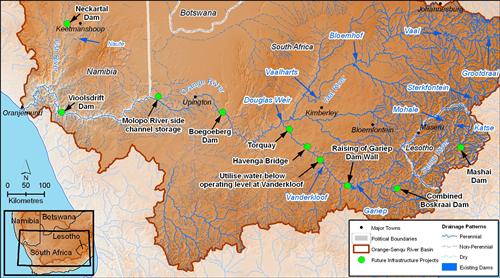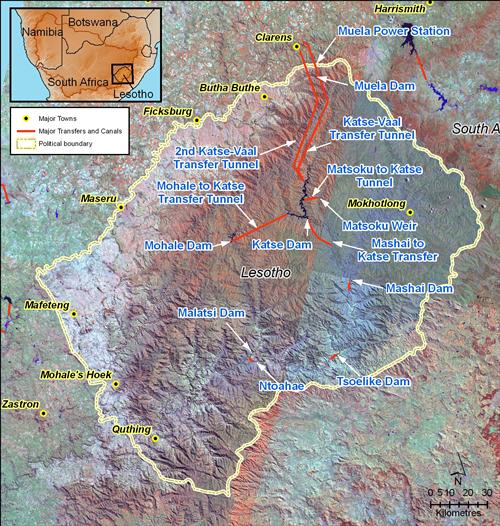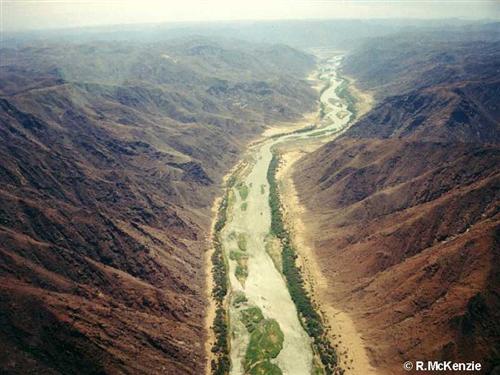Several new developments have been identified in the basin to provide for future water demands – especially in the Lower Orange River basin, but also in the lowlands of Lesotho. The proposed developments for the basin states are presented in the map below.

Future water infrastructure planned throughout the Orange-Senqu River basin.
Source:Hatfield 2009
( click to enlarge )
Botswana
Botswana has proposed irrigation projects in the basin area, primarily to support the establishment of vineyards in Tshabong to take advantage of the extensive sunshine and favourable wine grape growing conditions in the region. The water is to be sourced from the Waterberg aquifers, currently exploited to supply drinking water for Tshabong and surrounding villages. It is estimated that this part of the basin has sufficient groundwater resources to meet comfortably the water demand of the envisaged vineyards. However, a study by Veelen et al. (2008) argues that the Tsabong wellfield (which includes the Waterberg aquifers) has a current abstraction rate twice its sustainable rate of 300 m3/day. Given this, and the fact that the aquifer straddles Botswana and South Africa, it will be necessary to undertake joint studies of groundwater flows and recharge before this project proceeds to ensure neither country is negatively impacted.
Lesotho
Implementation of Phase 2 of the LHWP has been approved, to include:
-
The 145 m high dam at Polihali in Mokhotlong district
-
The tunnel/pumping from the Polihali reservoir to Katse Dam
Apart from that, there is considerable development planned and under construction to improve water supply in Lesotho’s lowlands. One example: From 2013, just 35 kilometres from Maseru, the new Metolong Dam will store the water of the Phutiatsana River and thus dramatically improve the reliability of Maseru’s water supply.

Phase II of the LHWP expands the current capacity with an additional dam and transfers.
Source:Hatfield 2009
( click to enlarge )
Namibia
In Namibia, the tender for the construction of Neckartal Dam, has been awarded in mid 2011. The Neckartal Dam will be situated on the Fish River, 40 km west of Keetmanshoop and will become the largest dam in Namibia. It will support about 5 000 ha of irrigated agriculture.
South Africa
In South Africa, it is likely that the Department of Water Affairs will need to consider raising the wall of Gariep Dam within the next decades.
The Boegoeberg Dam has a 677m long wall, reaching a height of 10,7 m. The dam was built in the 1930s, but sedimentation has since halved its capacity from 40 Mm³ to 20 Mm³. The site is one of several being considered for improvement. A new larger dam would provide additional storage and regulation capacity below Vanderkloof Dam (DWAF 2009).
Namibia/South Africa Vioolsdrift Dam Project
Namibia is currently interested in expanding irrigated agriculture along the lower Orange River, but does not currently have the surface water resources in-country to meet the irrigation demands of this project. In order to meet these needs, the possibility of a major dam at Vioolsdrift in South Africa is currently being investigated by Namibia and South Africa.
The dam would be downstream of the Vanderkloof Dam on the South African side of the river. Water and project costs would be shared by both countries, and the dam was proposed as part of the Lower Orange River Management Study (LORMS). Ultimate feasibility would depend on environmental flow requirements under South African law and would allow flows to the Orange River Mouth to be regulated (IRNAP 2006). To review the South African National Water Act or the LORMS study, please refer to the Document Library.

The proposed location for the Vioolsdrift Dam, on the Lower Orange River.
Source:McKenzie 1998
( click to enlarge )
